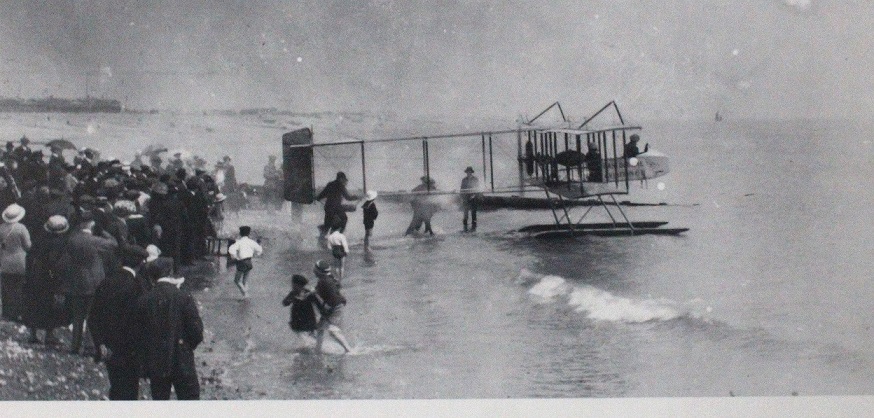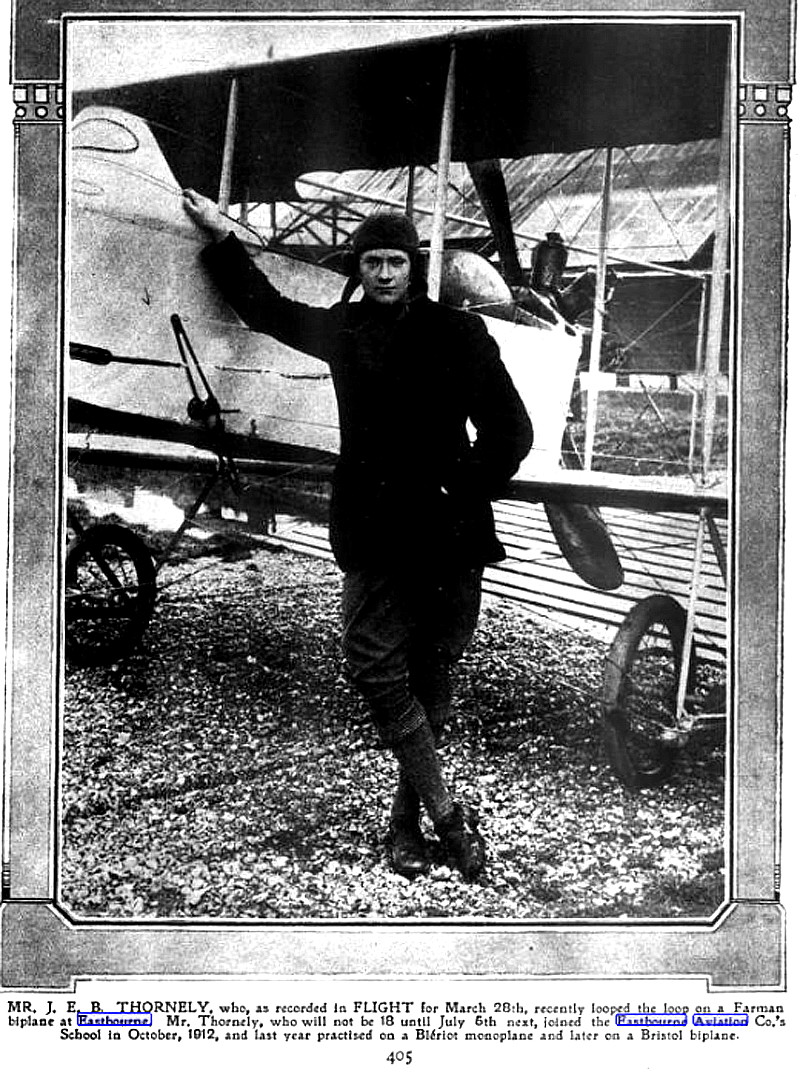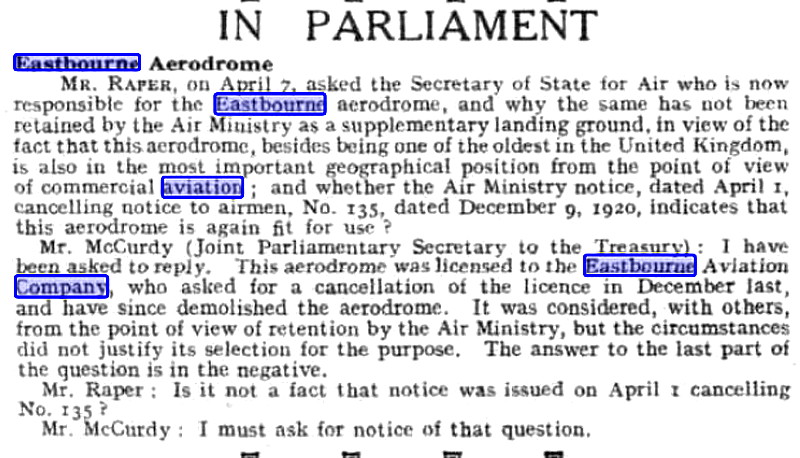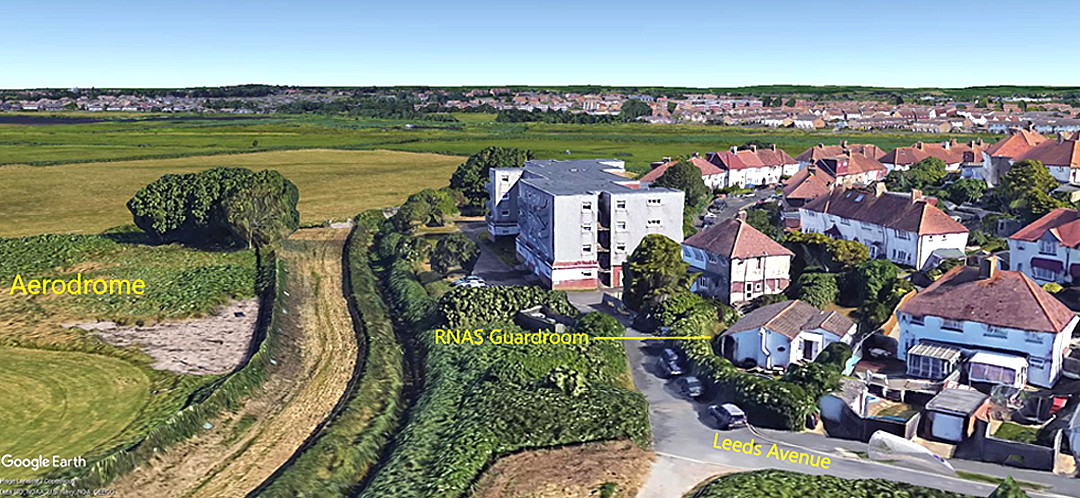Eastbourne flying sites
Note: This map only gives the location of Eastbourne within the UK.
EASTBOURNE see also EASTBOURNE DISTRICT GENERAL HOSPITAL
EASTBOURNE see also FROWD'S FLYING FIELD
EASTBOURNE see also WEST LANGNEY LEVEL
EASTBOURNE see also THE CRUMBLES
EASTBOURNE see also WILLINGDON LEVELS
EASTBOURNE see also WILMINGTON
EASTBOURNE: A display of flying?
Note: This picture is of a photograph in the Science Museum, London, for which a visit is highly recommended. It certainly looks as if this aircraft was not being used for 'joy-rides', at least when this photo was taken, but more likely it was giving a display of flying. The Daily Mail was very active in promoting aviation in those days.
I am being mistaken? I looks to me like a policeman is helping to launch the aeroplane.
EASTBOURNE: Seaplane operations
Note: A visit to Eastbourne in September 2015 to see if anything remained of the early flying sites, and whilst driving along the seafront, my very perceptive wife spotted this hotel. Could this really be the 'Royal Hotel' mentioned in records? The situation, near to the pier seems to be about right in most respects, but, I had expected to find a much grander establishment.
Operated by: Eastbourne Aviation Company
Location: On the beach near the Royal Hotel
Period of operation: 1919 to 1922 only?
NOTES: It appears pretty obvious that this is where the Eastbourne Aviation Company conducted their 'joy-ride' operations from.
A VERY INTERESTING PICTURE
In September 2024 I was kindly sent this picture by Mr Lee Rodes. It shows the Short 184 G-EALC (ex N2998) with the note that it was damaged. I cannot see any obvious signs of damage, so maybe it was damage to one of the floats?
I cannot be certain of course, but it does seem likely that it was being operated from the sea front near the Royal Hotel. The buildings in the background conform to the pattern shown on the 1914 map below.
What intriques me is why the Eastbourne Aviation Company decided to use a Short 184. This was a big aeroplane to be used for pleasure flights and was far from popular for operators. Much larger that the Avro 504K and 504N which were mostly favoured when converted to take two passengers. I can find no information regarding how many passengers G-EALC could carry - presumably more than just two?
Also, (unless I've missed something?), it would seem that only four Short 184s were placed on the British register. These being G-EBBM (ex N9096) and G-EBBN (ex N9118), both being registered to Seaplane Pleasure Trips Co. Ltd on 27.02.22. G-EBBM being WFU (Withdrawn From Use) 11.08.23 and G-EBBN being declared WFU 16.05.23. The fourth, G-EBGP (ex N2996) seemingly not being converted but registered to a company, (I cannot read the register entry), based in Llandudno, North Wales. I can find, (given only a brief search I must admit), no info about Seaplane Pleasure Trips.
So, it seems that the Eastbourne Aviation Company were ploughing a very lonely furrow operating a Short 184 in 1919. Or perhaps we should regard them as being visionary? Their example being registered G-EALC on the 28th August 1919. Surely towards the end of the 1919 summer season which doesn't seem to make any sense? Typically the scant information available also appears contradictory. The Civil Register showing it was de-registered 09.08.20, but other sources claim it was declared WFU 06.03.20.
I do thank heaven that, now over a quarter of a century ago, I decided that this project would be only a 'Guide'.
AND MORE NEWS AND VIEWS
A short while later Lee Rhodes very kindly sent me these items relating to EASTBOURNE spread over a period of time that he had found in his collection of old newspapers. They are not in chronological order, (it being beyond my ability to do so), but certainly do reflect, prior to WW2, just how rich and varied aviation history has been in this area.
A MICHAEL T HOLDER GALLERY
This gallery shows a variety of maps, pictures and articles gathered by Mike Holder, a great friend of this 'Guide', whilst looking into the aviation history of Eastbourne.
Note: The second item was published in Flight magazine on the 7th September 1912. The third item is of a Farman Longhorn operated from the beach. Date unknown but clearly pre-WW1.
Notes: Photo One was published in The Aeroplane on the 4th June 1914. Photo Two was published in Flight magazine on the 18th April 1914.
Note: These are four excerpts from an article published in the Eastbourne Gazette on the 4th February 1914.
This advert was published in the Eastbourne Chronicle on the 12th July 1919. The magazine article was published in Flight on the 14th April 1921.
Note: The newspaper article was published in the Eastbourne Gazette on the 15th April 1914. The magazine article was published in The Aeroplane on the 14th January 1920.
Note: The advert was published in The Aeroplane on the 7th January 1920.
COMMERCIAL REALITIES
I suspect it rather hard today to appreciate the commercial realities of operating such a concern. It is also very difficult to estimate what the charges for a short 'flip' were. I have seen it said that the charges for a short ‘flip’ equates to something between £50 to £100 in today's terms. Operating these early types of aircraft from the sea especially, the maintenance requirements were enormous, and, most of these aircraft had a very short viable life-span.
In those days the allure of having a flight would have been a tremendous attraction, far more so than today. But, after forking out for one flight, I suspect that few could justify the expense of having another and therefore it seems to follow that the relatively short period of such operations can be explained in this way? Plus, the potential customer base was really quite small and I suspect mostly restricted to the middle and upper classes. The working class in much of the UK couldn't afford a seaside resort holiday, (typically a fortnight), until after WW2 and even then it was by camping, staying in a caravan or perhaps a B&B or guest house. During the 1920s and 1930s many working class families could only afford a day trip to the seaside.
A common situation in aviation that still applies to many operations today of course - how many people sign up for a second hot-air balloon flight for example? With an ever diminishing market Major Fowler, the leading light at Eastbourne Aviation instigated Air Races and Flying Displays in an attempt to attract customers. He even opened a ‘School of Flying for Ladies’ which failed. The proverbial writing was ‘on the wall’ however and the company ceased trading in 1922.
EASTBOURNE: Major air display venue
NOTES: This is just an example for what goes on at many seaside resorts in recent years. In 2014, from the 14th to 17th August, the Red Arrows were booked to give displays, for the 'Airbourne: Eastbourne International Airshow' for four days in a row, equal to the 'Bournemouth International Air Festival' in terms of duration, for which 1.2 million spectators are claimed.
COVERED IN CONFUSION
In his excellent biography of Amy Johnson, David Luff states that, during her tour of England sponsored by the Daily Mail, it was arranged that she should fly in to "...a small flying field near to the town's Hampden Park." Because her ability to land an aircraft was bordering on abysmal at best, she flew in the day before to practise. It didn't help and in front of a large crowd the following day she completely screwed up, only landing on her fourth attempt.
It might seem odd today that somebody with such inadequate basic piloting skills could have reached Australia! However, it is not generally known, (nor was it then), that she smashed the undercarriage three times and seriously crashed her aircraft twice with extensive repairs being needed.
However, for the purposes of this 'Guide' I cannot work out where this "small flying field" was actually situated. It doesn't seem to fit in with the other sites listed. Can anybody help here?
EASTBOURNE (BUT WHERE?)
Eastbourne was the 57th venue in August for the 1929 Sir Alan Cobham's Municipal Aerodrome Campaign. Starting in May and ending in October one hundred and seven venues were planned to be visited. Mostly in England but with two in Wales and eight in Scotland. In the end, after a couple of crashes and other setbacks Cobham managed to visit 96 venues, which of course was still a magnificent achievement.
It is of course very tempting to think that on this visit he probably used either FROWD'S FIELD or WILMINGTON? But, experience has taught me to be very wary of jumping to such easy conclusions. If anybody can kindly offer advice, this will be most welcome. So, imagine my delight when Mike Holder, a great friend of this 'Guide', provided chapter and verse to prove the site used was WEST LANGNEY LEVEL. See seperate listing.
The aircraft Cobham used for this Tour was the DH61 'Giant Moth' G-AAEV, named 'Youth of Britain'. The punishing schedule he set himself seems astonishing today. See STOCKTON-on-TEES for more information. Better still, read his memoirs in A Time To Fly.
We'd love to hear from you, so please scroll down to leave a comment!
Leave a comment ...
Copyright (c) UK Airfield Guide













































